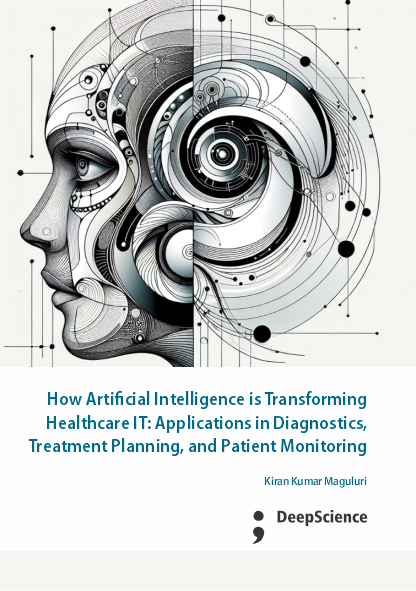Ethical challenges in artificial intelligence-driven healthcare systems
Synopsis
AI-driven healthcare systems present significant ethical challenges, including data privacy concerns, algorithmic bias, and decision-making transparency. Addressing these issues is crucial to ensure equitable access, maintain patient trust, and ensure that AI technologies are used responsibly, enhancing healthcare outcomes while safeguarding ethical standards and patient rights.
Keywords
Algorithmic Bias, Data Privacy, Ethical Challenges, Healthcare, Patient Rights, Transparency
8.1. Introduction
The healthcare services provided by institutions and hospitals are inadequate in proportion to the increase in population and life expectancy. The total number of people who have difficulty accessing health services due to economic and geographical factors is high, and many people may experience medical errors when accessing health services. Hospitals and healthcare systems use simulations and make decisions with the help of developed innovative solutions such as management of hospital resources, diagnosing diseases, predicting possible complications, and the active bed occupancy rate created from electronic health records or other data. This is becoming increasingly important for designing resources, making predictions of future events using artificial intelligence-driven advances, and taking special measures.
Artificial intelligence applications require the use of more extensive and real data in the medical field and are a broad topic. The most significant benefit is creating personalized treatments, preventing diseases by predicting them, presenting possible complications at the time of the disease, and thus maintaining effective allocation of resources and hospital budgets at a sufficient level. Although it is desirable to meet the demand for population growth, costs have increased, and inequalities between underdeveloped and developing countries have grown. The use of artificial intelligence technologies in hospital management has the potential to reduce these adverse effects, but on the other hand, artificial intelligence can bring some ethical and legal issues, specifically regarding the accuracy and privacy of medical data, which must be handled deliberately (Ramanakar, 2023). Additionally, wealth and inequality can prevent direct access to health services. This study aims to evaluate the potential importance and problems of using artificial intelligence in the healthcare sector.
8.1.1. Background of AI in Healthcare
AI in healthcare has seen rapid growth. The nature of the data used in healthcare makes it an exceptionally ideal field to deploy AI techniques. The determinate data labels make models more explainable and thus help AI to be more persuasive for clinicians. Modern techniques have made AI applications not just the prescription recognition and notes interpretation - tasks that the rules of clinical practice, distinctive ECG rhythms that are tough to identify – tasks that commonly have been found especially challenging for humans.
AI services have been quickly developed and increased in the healthcare field. In medical imaging, the deep learning system showed human-level performance in distinguishing skin cancer and diagnosing diabetic macular edema from fundus photography. Various AI service companies already offer services in healthcare, such as note-taking and prescription reminder services. An AI symptom checker relying on the patient's conversations to triage clinical conditions has been created. However, implementing complementary AI services in healthcare also involves various risks, especially the risks related to data utilization (Syed, 2017).
Fig 8 . 1 : Ethical Challenges in AI-Driven Healthcare.
8.2. Ethical Principles in Healthcare
It is generally agreed that the following ethical principles are key guiding principles in healthcare:
Beneficence: This is the duty to promote the well-being of the patient.
Non-maleficence: This is the duty of care and implies that clinicians should seek to protect their patients.
Autonomy: Patients, where appropriate, are given the information and the option to make decisions about their own care. They have the ultimate control.
Justice: Principles of universal healthcare are generally accepted within the community.
Respect: Clinicians are expected to treat each of their patients with respect.
These ethical principles are intended to guide the actions and practices of healthcare professionals and also standards and regulations at the macro level. The prospect of AI-driven healthcare systems raises some critical questions of principle and practice within medicine:
Do AI-based technologies observe the ethical principles or manipulate them for a very different mode of healthcare delivery?
In what ways do AI-based systems challenge or amplify our experiences and understandings at the individual, institutional, and social levels in medicine?
Equation 1 : Fairness in AI Predictions
8.2.1. Beneficence and Non-Maleficence
The ethical principles of beneficence and non-maleficence require that the healthcare provider act in the best interest of the patient and do no harm. When these principles are applied to the field of AI, the focus is not just on how AI systems are implemented but also on the societal benefits and harms that come from AI. Non-medical gains from performing treatments and surgeries where substantial risks are involved are part of good treatment, just as reducing risks due to disease, suffering, and restrictions. As AI systems can be implemented to aid in the prevention of medical errors, incorrect diagnoses, diseases acquired due to poor hygiene, and the potential for diseases from air pollution, the principle of beneficence is evidenced. However, other aspects of the implementation of AI in healthcare must be considered to evaluate if the application of medical AI positively impacts patient well-being and welfare while minimizing harm. Ensuring digital health equity in disadvantaged areas, the implications of AI for human contact, and the psychological implications of over-reliance or over-investment of trust by patients and healthcare workers in AI are important yet often unexplored (Danda, 2023).
When held to the principles of beneficence and non-maleficence, regulatory bodies will need to provide additional guidance on other related ethical implications such as: “Low costs do not mean benefits for all. As low costs may still make the technologies unaffordable in some areas, it is necessary to prevent epistemic injustice by making the right technologies of the right quality and at reasonable costs available for all vulnerable populations. This requires a funding and reimbursement policy in the healthcare systems for telehealth and AI technologies. With a low level of acceptability, support, and training of all potential users regarding their establishment of trust and competencies in using telehealth and AI technology are crucial for ensuring a high level of acceptability.”
8.3. AI Applications in Healthcare
AI is being used in healthcare, mainly to predict disease and improve patient management (Shakir, 2024). Many projects have been developed by large companies, with significant resources being invested in these systems. Some public health services use these systems to improve the follow-up of patients with chronic illnesses. However, as AI has high data requirements, some of these projects run only in a few wealthy countries with very strong healthcare data collection capabilities. Small companies have promoted the development of more focused products within the market, such as chatbots designed to help physicians, especially primary physicians, to increase patient throughput.
Fig 8 . 2 : Artificial Intelligence Ethics and Challenges in Healthcare Applications.
Several predictive models have been developed to detect both diseases and events that hurt health. These models have been applied to dementia, depression, and schizophrenia, to identify people with a higher risk of developing a disease to initiate treatment earlier. They have also been implemented in trauma units to predict the severity of a patient’s medical condition. Research groups have developed wireless signals that pass through walls, which can be used to monitor people inside their homes without attaching a device to their bodies. Among other uses, this technology has been proposed for detecting changes in the gait pattern of elderly people living alone. Data capture is performed through wireless devices placed throughout the living quarters, using machine learning techniques to create models capable of identifying changes in the gait pattern, possibly due to an abnormal event.
8.3.1. Diagnostic Systems
A substantial part of the healthcare data is patient imaging which includes X-ray, MRI, and CT scans. The use of machine learning in AI to analyze medical images requires large volumes of data; however, actual repositories of clinical images have been designed by algorithms in diagnostic models. Even using synthetic data is complicated when it comes to clinical routines with a different number of false signals. Moreover, many proprietary datasets are inaccessible to researchers but are available for companies that significantly improve the quality of their diagnostic models. They train the algorithms on paid proprietary data, suppress the human ability to collect and analyze images and reduce diagnostic independence. The use of such data inevitably raises the risk of decision bias.
Another challenge of machine learning-based diagnostic systems is when the algorithm is trained on data from one clinic but then is used in other places without validation of new data. Normally, obtaining a model requires gathering, pre-processing, and the training process. When the model is transferred to another hospital, the process is no longer controlled as the training part. Even if the change of hardware is expensive, it is much cheaper than the creation of a database (Nampalli, 2024).
8.4. Ethical Challenges in AI-Driven Healthcare Systems
Ethical challenges in the AI-driven healthcare timeline can emerge through the complete patient-centric AI-empowered digital journey, right from straightforward, standardized data collection throughout storage in a patient-oriented medical database, as well as during the data mining and preparation steps of the information-related model. AI-driven decision-making in healthcare is a method, not a product. Healthcare problems continue, and patient care and knowledge will also continue. Patients, treatment providers, and governing authorities will also question the operation and quality of AI decision-making methods, based on the healthcare and safety outcomes of decisions and how well the needs of all involved stakeholders are satisfied.
Artificial intelligence encourages clinical decision-making and reduces the accuracy of caregivers. One ethical concern is that reliance on AI may reduce individual caregivers' responsibility and that AI will go beyond human operations. Publicly known examples of surgical robotics that can perform tasks under unknown conditions and store data suggest that it is important to clarify what tasks are appropriate to be done by a computer and what should be decided by a person. Organizations need to be transparent about how AI is intended to improve their business. All possible consequences should be established, including the ethical and public consequences for all affiliated parties.
Fig 8 . 3 : Ethical Challenges in AI-Driven Healthcare Systems.
8.4.1. Bias and Discrimination
Modern medicine is a complex socio-technical system, where the human and technological elements are fundamental to considering any kind of biomedical innovation. Due to machine learning's dependence on large-scale data repositories, as well as the black box nature of many artificially intelligent systems, there are several ethical challenges imbued within the process of building and deploying AI in healthcare. Bias and discrimination are associated with AI's reliance on training datasets, and the potential harm of inaccurate predictions is reflective of grander ethical concerns about how AI should be designed. This is due to the increasing prominence and deployment of AI and necessitates consideration at the medical education, clinical practice, research, and policy levels.
The ethical issues accompanying AI models themselves include transparency and explainability of machine learning algorithms, as well as compromise and standardization between the competing complexities of accuracy, simplicity, and fairness. Many AI systems do not have frames of interpretability that are simple enough for most medical professionals to understand (Kothapalli et al., 2022). Combined with unique challenges to the medical AI organization over AI ownership, conflict of interest, and liability, this often leads to unpredictable actions within a clinical setting. Despite these challenges, the nuanced and sophisticated incorporation of AI within new learning paradigms for healthcare professionals can counteract negative impact and complexity.
8.5. Regulatory Frameworks and Guidelines
Regulatory frameworks and guidelines are advanced in some countries around the world and quite underdeveloped in others. Additionally, most of the regulatory frameworks focus on advanced analytics, which provides guidelines on clinical decision support systems. It is important to realize that AI in the healthcare system is much broader than AI DSS or AI Dct. Additionally, guidelines are a step in the right direction to resolve issues related to data privacy. However, they are quite generic and do not address the specifics of having AI-driven healthcare systems. Experts in the healthcare systems and AIs need to have a common understanding and set of rules on model validation and reproducibility, how the sensitivity around inputs, outputs, and model hidden layers should be given, what the threshold should be for transparency and explainability, how AI-driven healthcare systems should be integrated into healthcare practice, what the ethics of developing versus using AI in healthcare are, how the risks are understood and mitigated, and how liability should be allocated.
For instance, guidance on AI in healthcare focused on the explainability of 'black box' systems, continuous improvement and adaptability, and clinical evidence validation of adaptive learning systems. It is important to have similar guidelines and validated regulatory models. Collaboration between regulatory agencies can only bring best practices, but it might shift the conversation towards a more global scale. Thus, the collaboration should be expanded and allow the framework they develop to be implemented all around the world. These organizations, however, have excessive workloads already, and there is not enough talent and infrastructure to handle all the developing healthcare systems using AI. Thus, a central body should take responsibility and have oversight of AI-driven healthcare practice. It can ease the pressure on the legislated but bound organizations and the stretched regulatory bodies by providing a benchmarking service to ensure guidelines are adhered to and provide a monitoring system centrally. This kind of benchmarking and monitoring service could have a very positive impact on the complexity-efficiency relationship (Subhash et al., 2022).
Equation 2 : Accountability in Decision-Making
8.5.1. HIPAA Compliance
HIPAA, the Health Information Portability and Accountability Act, is stark in its obligations and quite challenging in today's world of machine learning because healthcare-distributed companies process numerous electronically protected health information (ePHI), which implicates HIPAA compliance. A scoring method has been proposed in which a HIPAA privacy checklist is used to obtain weights for the protected health information-specific individual requirements of the HIPAA Privacy Rule, which will then be used to compute a weighted sum that represents an entity's likelihood of being non-compliant. These infractions could hold liable several important actors, including the vendors that developed the software, the entities that installed and used the software, and the doctors who trained and validated the model. Ideally, all should be responsible for the AI module output. A central question is how these regulations change if the healthcare technology system or software involves advanced machine learning and AI algorithms (Sondinti et al., 2023).
For example, is it still the case that a medical record contains all information about the medical condition? Or does AI software that extracts and uses a summary to tag, diagnose, or treat a patient require different rules applied to this information model output? With traditional health systems, the EHR vendor is one of the HIPAA business associates responsible for maintaining EHR data. On the contrary, in an AI platform-based model, the EHR holdings are not solely handled by the EHR vendor. Therefore, not only is the EHR vendor a business associate responsible under HIPAA but so too are the developers and vendors embedding the models at the AI platform level. Particularly, if data is shared back and forth, then both the data-sharing agreement and other contractual agreements must apply.
Fig 8 . 4 : Applications of artificial intelligence in health care.
8.6. Conclusion
We observe that despite the promised advantages and growing commitment to AI-driven healthcare applications, there is a clear paucity of research linking AI to healthcare ethics. This research adopts a systems-thinking approach to critically investigate the ethical challenges associated with AI-driven healthcare systems. A comprehensive framework of eight distinct dimensions and 21 sub-dimensions is proposed. The findings advocate the unavoidable necessity of ethics, incorporating the social as well as business perspectives in developing and deploying AI in healthcare applications. By understanding the ethical concerns and challenges of AI-driven healthcare systems, we can address them in the emerging design and development process. Furthermore, host governments and AI systems developers can minimize these challenges and capitalize on the associated advantages of AI-driven healthcare systems (Vankayalapati et al., 2023).
The findings of this research present an urgent call for the governance of AI ethics. The extensive variety of ethical challenges from both the business and social dimensions necessitate this approach. By carefully considering the implications of AI-driven healthcare systems, government bodies, and other stakeholders can responsibly deliver the benefits of these applications without posing an overall hazard. The association between AI technology and healthcare ethics in this research has relevance in the medical domain and may also serve as a practical guideline for AI system developers in other commercial sectors. Despite its inherent flexibility to evolve as new perceptions and ethical challenges emerge, our research represents both the first step and an important shot toward the engagement of the AI, healthcare, and ethics domains. We encourage further research and development to advance knowledge about the ethical implications of AI-driven healthcare systems and to promote responsible utilization.
8.6.1. Future Trends
In this chapter, we have established that the application of AI in healthcare generates new ethical concerns in addition to well-known problems associated with healthcare, including the nature of the healthcare relationship, the fiduciary obligations of healthcare professionals, the responsibilities of institutions, and the distribution of care. As AI continues to develop and our reliance on these systems increases, the requirements of the healthcare environment will need to be reset to reflect the growing importance of the role of data and algorithms. Certain trends are identifiable that may develop progressively in the medium to long term. The speed of this transformation of healthcare will depend to a large extent on the accessibility, accuracy, and effectiveness of the new digital technologies and AI methods. Ordinary consultation has been the basis of the clinician-patient relationship for millennia, but access to telemedicine is expected to continue to increase exponentially with the widespread use of AI as a result of its considerable benefits (Maguluri et al., 2022). The withdrawal into the home of citizens examined by telemedicine will also affect the territory historically occupied by hospitals, which could then focus on serious and specialized pathologies that cannot be managed by telemedicine. The consultants could thus only see patients with serious or complex problems. Once the support obligation for all the morbidities that the territorial health services cannot identify is removed, subsequent costs and legal disputes will be reduced. The voice signals could also perform medical triage effectively in clinical, health, and wellness settings.
References
Danda, R. R. (2023). AI-Driven Incentives in Insurance Plans: Transforming Member Health Behavior through Personalized Preventive Care. Letters in High Energy Physics.
Kothapalli Sondinti, L. R., & Yasmeen, Z. (2022). Analyzing Behavioral Trends in Credit Card Fraud Patterns: Leveraging Federated Learning and Privacy-Preserving Artificial Intelligence Frameworks. Universal Journal of Business and Management, 2(1), 1224. Retrieved from https://www.scipublications.com/journal/index.php/ujbm/article/view/1224
Maguluri, K. K., Pandugula, C., Kalisetty, S., & Mallesham, G. (2022). Advancing Pain Medicine with AI and Neural Networks: Predictive Analytics and Personalized Treatment Plans for Chronic and Acute Pain Managements. In Journal of Artificial Intelligence and Big Data (Vol. 2, Issue 1, pp. 112–126). Science Publications (SCIPUB). https://doi.org/10.31586/jaibd.2022.1201
Nampalli, R. C. R. (2024). AI-Enabled Rail Electrification and Sustainability: Optimizing Energy Usage with Deep Learning Models. Letters in High Energy Physics.
Ramanakar Reddy Danda, Z. Y. (2023). Impact of AI-Powered Health Insurance Discounts and Wellness Programs on Member Engagement and Retention. Letters in High Energy Physics.
Shakir Syed. (2024). Planet 2050 and the Future of Manufacturing: Data-Driven Approaches to Sustainable Production in Large Vehicle Manufacturing Plants. Journal of Computational Analysis and Applications (JoCAAA), 33(08), 799–808. Retrieved from https://www.eudoxuspress.com/index.php/pub/article/view/1453
Sondinti, L. R. K., Kalisetty, S., Polineni, T. N. S., & abhireddy, N. (2023). Towards Quantum-Enhanced Cloud Platforms: Bridging Classical and Quantum Computing for Future Workloads. In Journal for ReAttach Therapy and Developmental Diversities. Green Publication. https://doi.org/10.53555/jrtdd.v6i10s(2).3347
Subhash Polineni, T. N., Pandugula, C., & Azith Teja Ganti, V. K. (2022). AI-Driven Automation in Monitoring Post-Operative Complications Across Health Systems. Global Journal of Medical Case Reports, 2(1), 1225. Retrieved from https://www.scipublications.com/journal/index.php/gjmcr/article/view/1225
Syed, S. (2017). The Role Of Manufacturing Finance Applications In Driving Predictive Analytics For Improved Vehicle Production And Cost Efficiency.
Vankayalapati, R. K., Sondinti, L. R., Kalisetty, S., & Valiki, S. (2023). Unifying Edge and Cloud Computing: A Framework for Distributed AI and Real-Time Processing. In Journal for ReAttach Therapy and Developmental Diversities. Green Publication. https://doi.org/10.53555/jrtdd.v6i9s(2).3348














